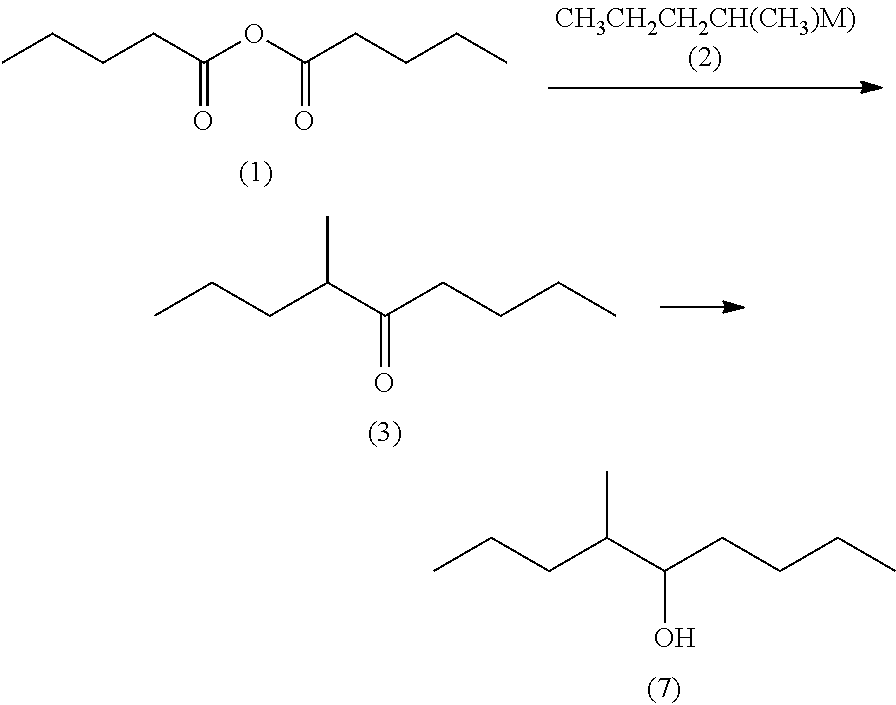Processes for preparing 4-methyl-5-nonanone and 4-methyl-5-nonanol
a technology of 4methyl-5-nonanone and process, which is applied in the preparation of halogenated hydrocarbons, carboxylic compound preparations, carbonyl compound preparations, etc., can solve the problems of difficult industrial production of reactors, and achieve high yield, low cost, and high purity
- Summary
- Abstract
- Description
- Claims
- Application Information
AI Technical Summary
Benefits of technology
Problems solved by technology
Method used
Image
Examples
example 1
Preparation of 2-chloropentane (5: X═Cl)
[0176]
[0177]2-Pentanol (4) (296.71 g, 3.366 mol), pyridine (479.25 g, 6.06 mol), and N,N-dimethylformamide (DMF) (1009.80 g) were added to a reactor at room temperature and stirred at from 0 to 5° C. for 18 minutes. Next, methanesulfonyl chloride (MsCl) (6: X═Cl, R=Me) (539.81 g, 4.71 mol) was added dropwise to the reactor at an internal temperature of 10° C. or below. After the completion of the dropwise addition, the reaction mixture was heated to an internal temperature of from 60 to 65° C. and stirred for 11.5 hours. After lowering the internal temperature to 30° C., acetic acid (363.83 g) and water (1683.00 g) were added to the reaction mixture to cause phase separation and the aqueous phase thus obtained was removed. Then, sodium hydrogen carbonate (84.15 g) and water (841.50 g) were added to the organic phase to wash the same, followed by phase separation and removal of the aqueous phase. The organic phase thus obtained was concentrated...
example 2
Preparation of 2-chloropentane (5: X═Cl)
[0180]
[0181]2-Pentanol (4) (296.71 g, 3.366 mol), pyridine (479.25 g, 6.06 mol), and N,N-dimethylacetamide (DMAC) (1009.80 g) were added to a reactor at room temperature and stirred at from 0 to 5° C. for 14 minutes. Next, methanesulfonyl chloride (MsCl) (6: X═Cl, R=Me) (539.81 g, 4.71 mol) was added dropwise to the reactor at an internal temperature of 10° C. or below. After the completion of the dropwise addition, the reaction mixture was heated to an internal temperature of from 60 to 65° C. and stirred for 9.5 hours. After lowering the internal temperature to 30° C., acetic acid (363.83 g) and water (1683.00 g) were added to the reaction mixture to cause phase separation and the aqueous phase thus obtained was removed. Then, sodium hydrogen carbonate (84.15 g) and water (841.50 g) were added to the organic phase to wash the same, followed by phase separation and removal of the aqueous phase. The organic phase thus obtained was concentrated...
example 3
Preparation of 2-chloropentane (5: X═Cl)
[0182]
[0183]2-Pentanol (4) (88.15 g, 1.00 mol), pyridine (142.38 g, 1.80 mol), and N,N-dimethylformamide (DMF) (300.00 g) were added to a reactor at room temperature and stirred at from 0 to 5° C. for 39 minutes. Next, benzenesulfonyl chloride (6: X═Cl, R=Ph) (247.25 g, 1.40 mol) was added dropwise to the reactor at an internal temperature of 10° C. or below. After the completion of the dropwise addition, the reaction mixture was heated to an internal temperature of from 60 to 65° C. and stirred for 8 hours. After lowering the internal temperature to 30° C., acetic acid (108.09 g) and water (500.00 g) were added to cause phase separation and the aqueous phase thus obtained was removed. Then, sodium hydrogen carbonate (25.00 g) and water (500.00 g) were added to the organic phase to wash the same, followed by phase separation and removal of the aqueous phase. The organic phase thus obtained was concentrated in a reduced pressure and the residue...
PUM
| Property | Measurement | Unit |
|---|---|---|
| weight ratio | aaaaa | aaaaa |
| temperature | aaaaa | aaaaa |
| temperature | aaaaa | aaaaa |
Abstract
Description
Claims
Application Information
 Login to View More
Login to View More - R&D
- Intellectual Property
- Life Sciences
- Materials
- Tech Scout
- Unparalleled Data Quality
- Higher Quality Content
- 60% Fewer Hallucinations
Browse by: Latest US Patents, China's latest patents, Technical Efficacy Thesaurus, Application Domain, Technology Topic, Popular Technical Reports.
© 2025 PatSnap. All rights reserved.Legal|Privacy policy|Modern Slavery Act Transparency Statement|Sitemap|About US| Contact US: help@patsnap.com



